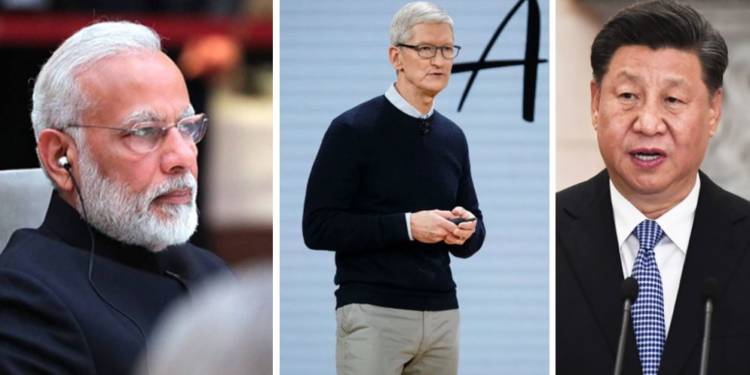If the chatter across political corridors is any indication, Apple is set to pack its bags from China and move a significant part of its flagship iPhone production to India. According to ET, several high profile meetings between Apple’s senior executives and top-ranking government officials over the last few months have paved the way for these developments.
Apple is considering moving about 20% of its iPhone production capacity in China to India because of the massive supply chain disruption in the wake of coronavirus pandemic that has broken the back of the manufacturing ecosystem of China.
The officials expected Apple to produce up to $40 billion worth of smartphones, mostly for exports through its contract manufacturers Wistron and Foxconn, availing the benefits under the recently unveiled Production-Linked Incentive (PLI) scheme.
If these developments lead to any fruition, the Silicon Valley Company could become India’s largest exporter superseding Reliance Industries whose exports from India in FY20 stood at ₹202,830 crores ($26.8 billion). India’s total exports are estimated to have been $446 billion for April 2019 to January 2020.
The PLI scheme was introduced last month to attract investments in electronics manufacturing. The scheme offers a production-linked incentive to boost domestic manufacturing and attract large investments in mobile phone manufacturing and specified electronic components, including assembly, testing, marking, and packaging (ATMP) units.
The central government has put aside a whopping Rs. 40,995 crore budget, for five years, under this scheme. To avail the PLI scheme benefits, a company must manufacture at least $10 billion worth mobile phones in a phased manner between 2020 and 2025.
Although the Apple executives have cast some doubts over the government’s ambitious PLI scheme—the Union government has assured that it is more than willing to address the problems and iron out the flaws.
The chain of events had started last year in December when Prime Minister Narendra Modi had a meeting with senior executives of Apple, Samsung, and domestic handset company Lava.
Since then, India has been attempting to build a robust domestic manufacturing sector in smartphones through a slew of major and sweeping policy changes.
Apple in China, directly and indirectly, employs about 48 lakh people and if it moves out of Mainland China, a large portion of the workforce will be rendered jobless.
Apple sales in India generate about $ 1.5 billion. In comparison, its production in China is worth about $ 220 billion, of which it exports products worth $ 185 billion. Therefore it will be a fight till the end to bring Apple to India but the government has been showing the resolve to slog it out, something which the previous regimes lacked.
India has overtaken the United States of America to become the 2nd largest manufacturer of smartphones in the world, trailing China. Make in India has turned the tide in India’s favor making India a global hub for manufacturing which is the principal aim of the ‘Make in India’ Policy. In 2014, there were only 2 manufacturing units in India but since the launch of ‘Made in India’ which propelled the scene in an impressive manner, the number had increased to 123 units in 2017 alone.
Wistron, one of Apple’s contract manufacturers is already making Apple’s low-priced iPhone SE model since 2017 in its Bengaluru unit where it currently assembles the iPhone 6S and 7 models.
Reported earlier by TFI, Foxconn, the largest electronics manufacturer in the world and fourth largest Information Technology Company by revenue has also shown resolve to move more of its iPhone manufacturing business to India. The company already manufactures smartphone units Xiaomi and Nokia at the assembly units located in Andhra Pradesh and Tamil Nadu.
The Coronavirus pandemic is set to bring about a change in the manufacturing ecosystem of the world. Once dubbed as the ‘factory of the world’, China has its task cut out as several countries and companies are looking to pack their bags and move out.
With a bleak future and a threat of financial sanctions and reparations, the companies are sensing it is the right time to dump China and find a more suitable and conducive environment. Consequently, India has put its hands up to take the mantle and so far things have been moving in the right direction.

































